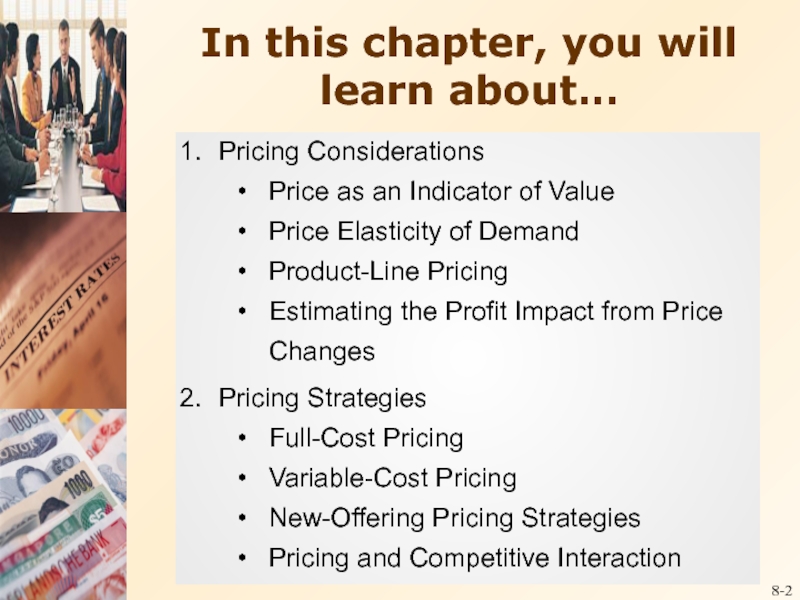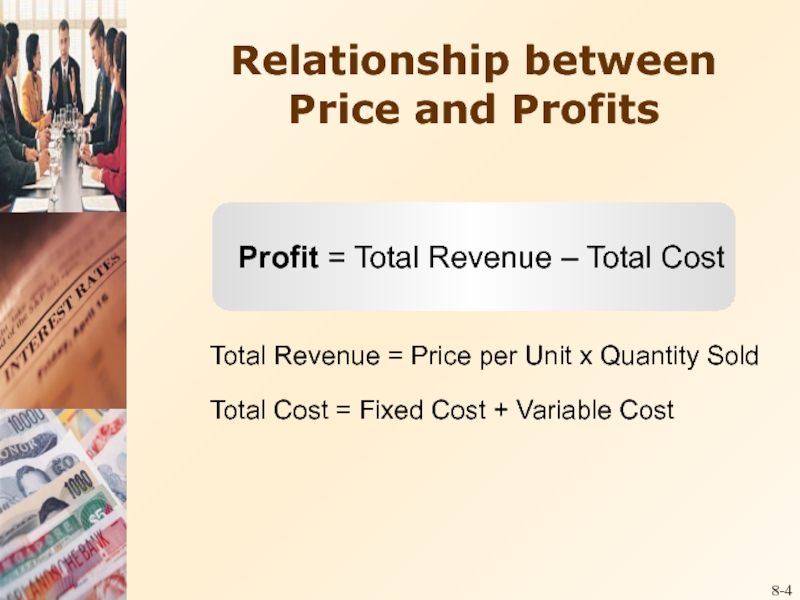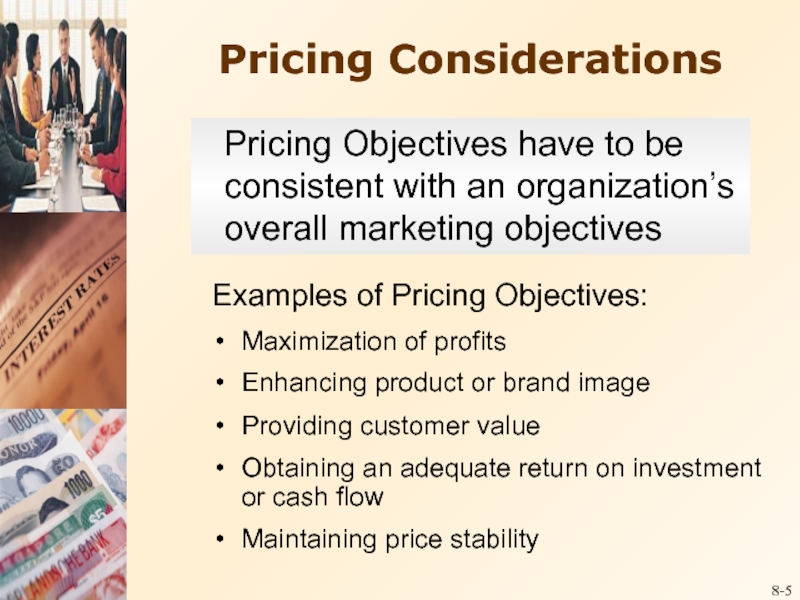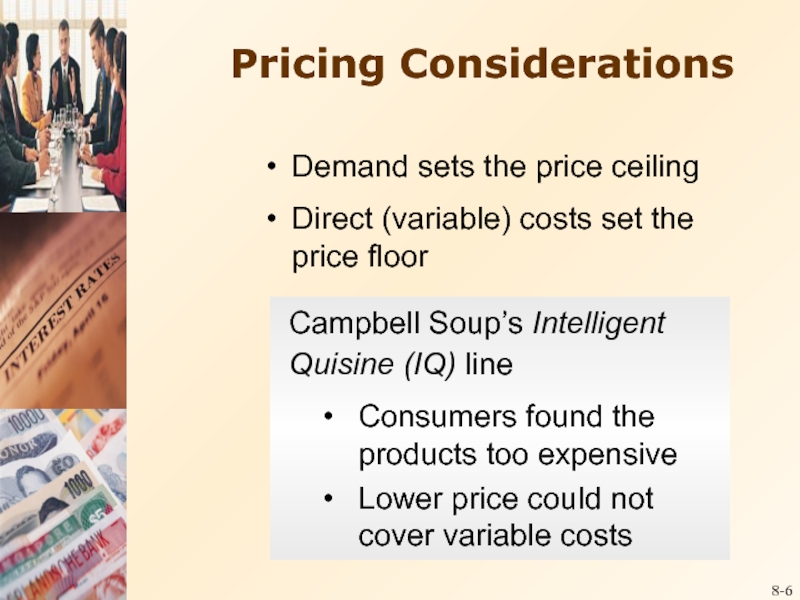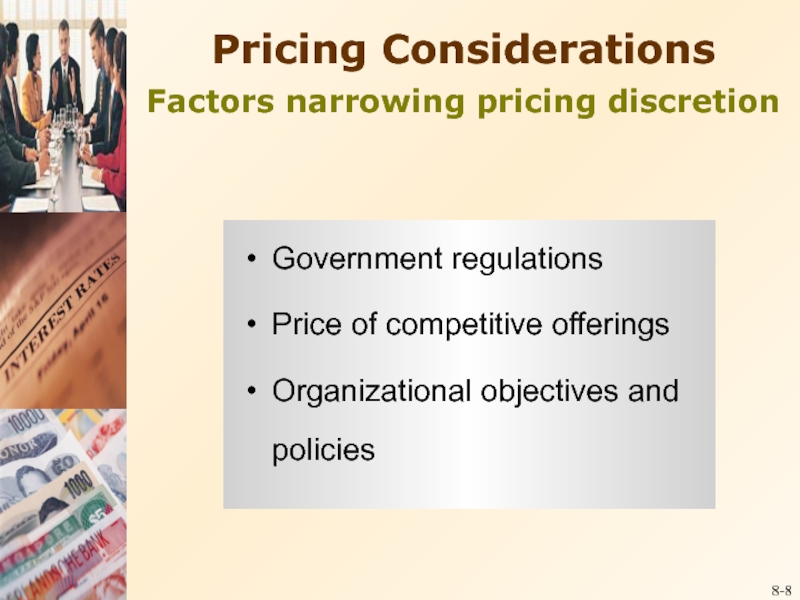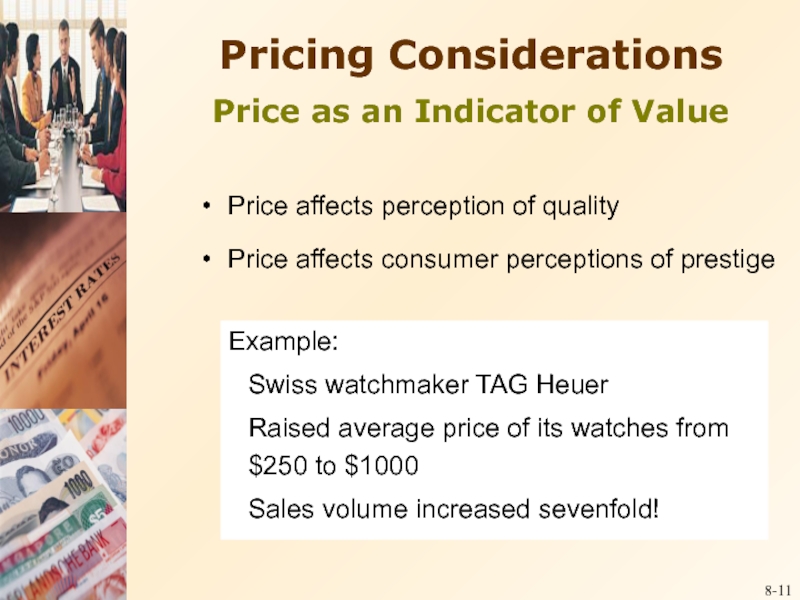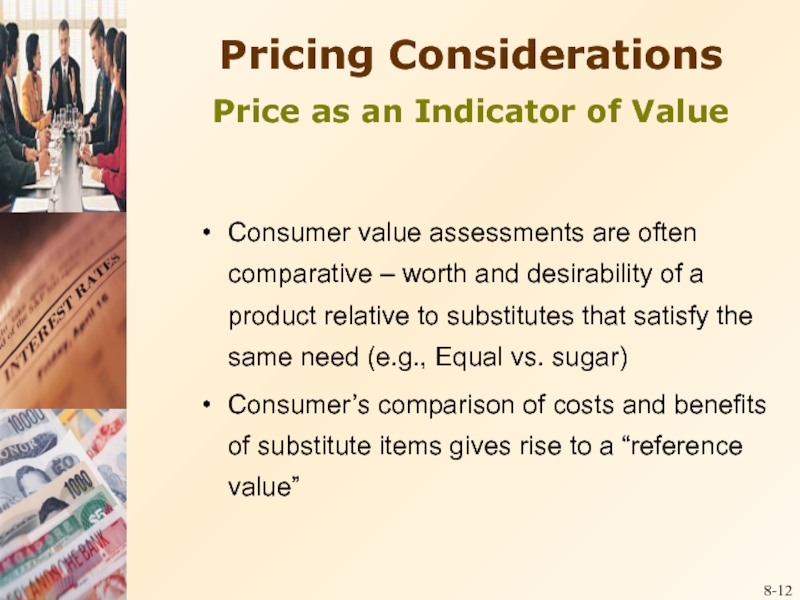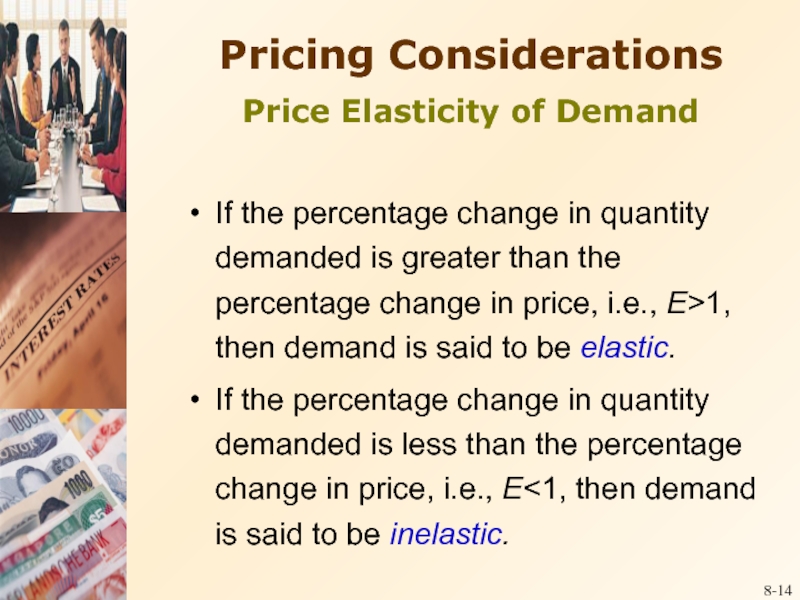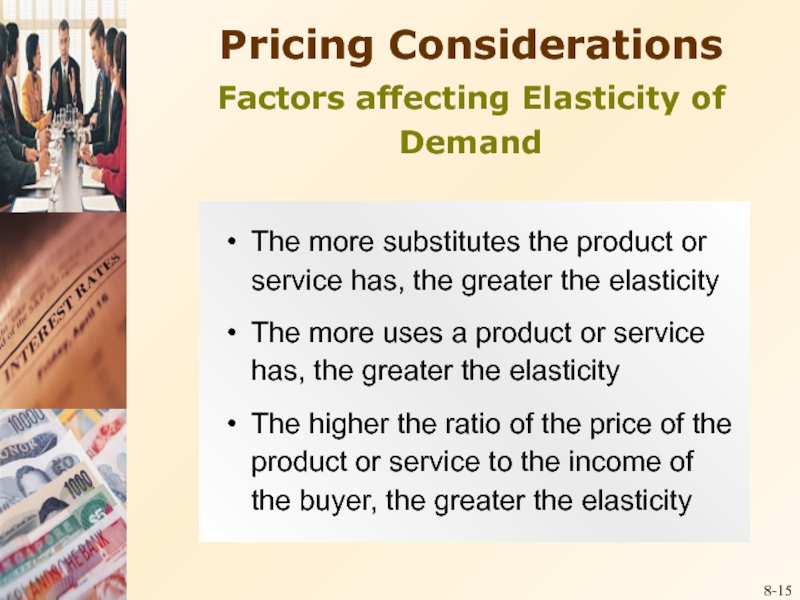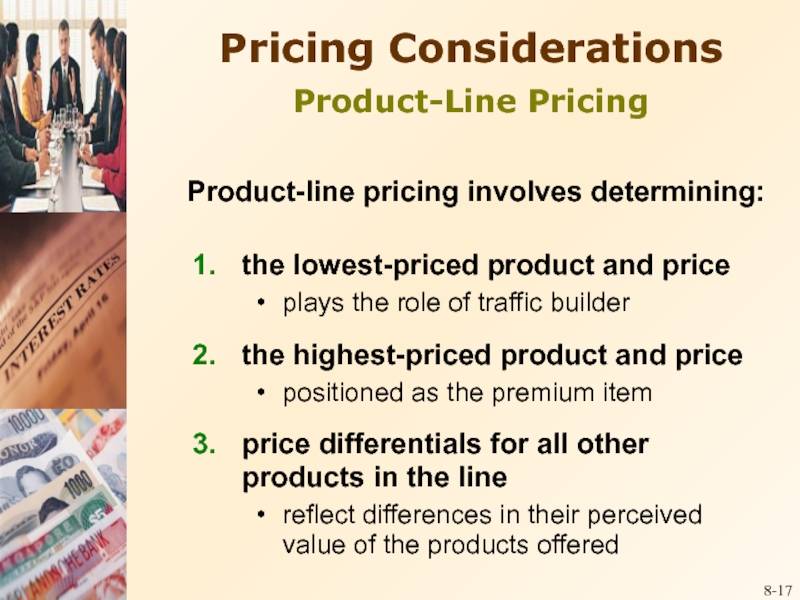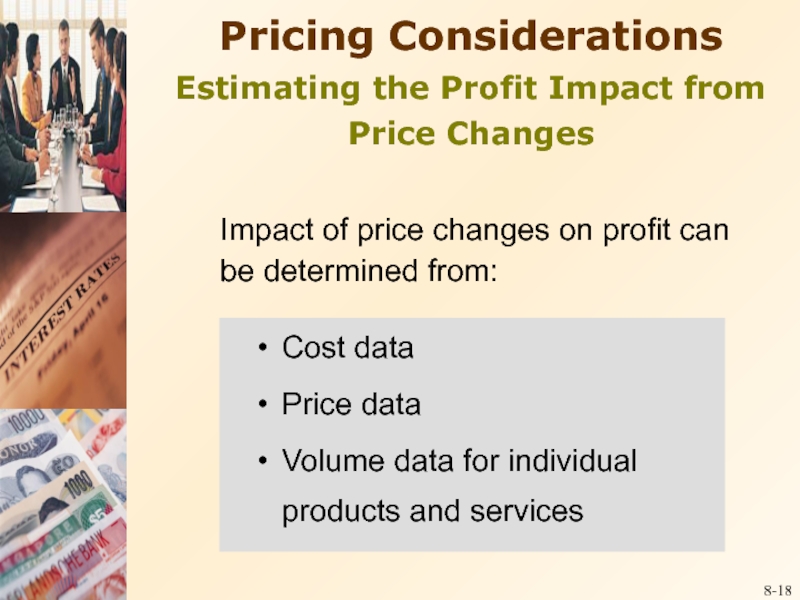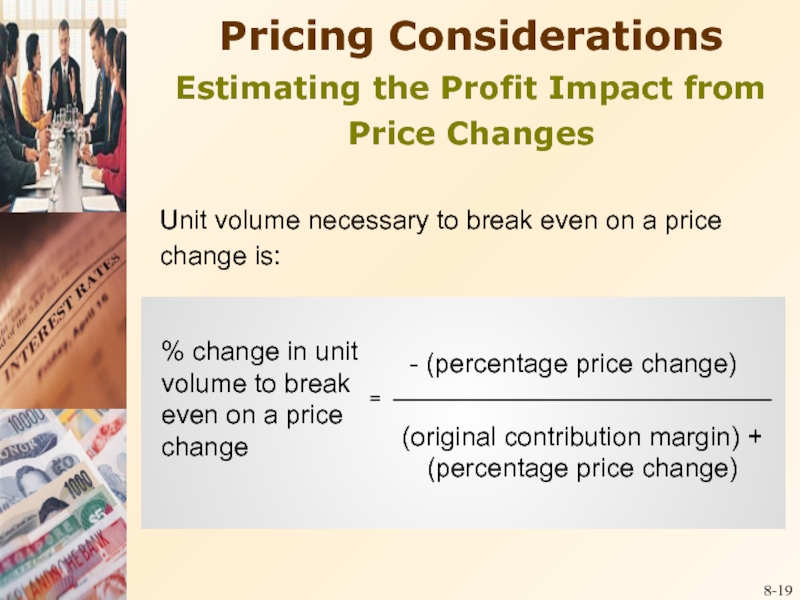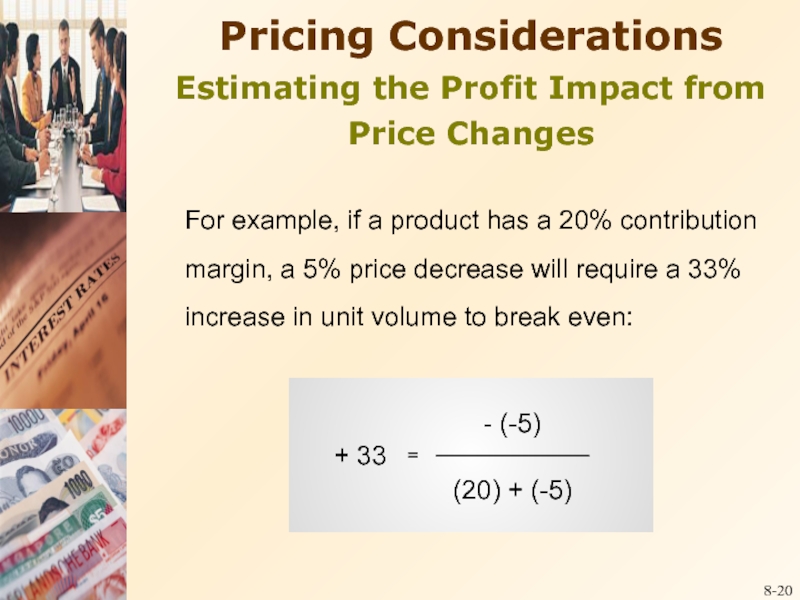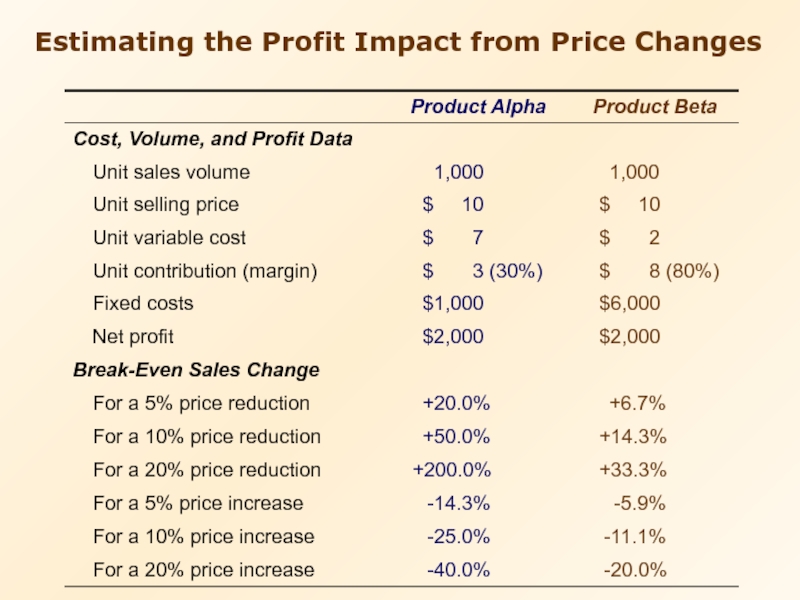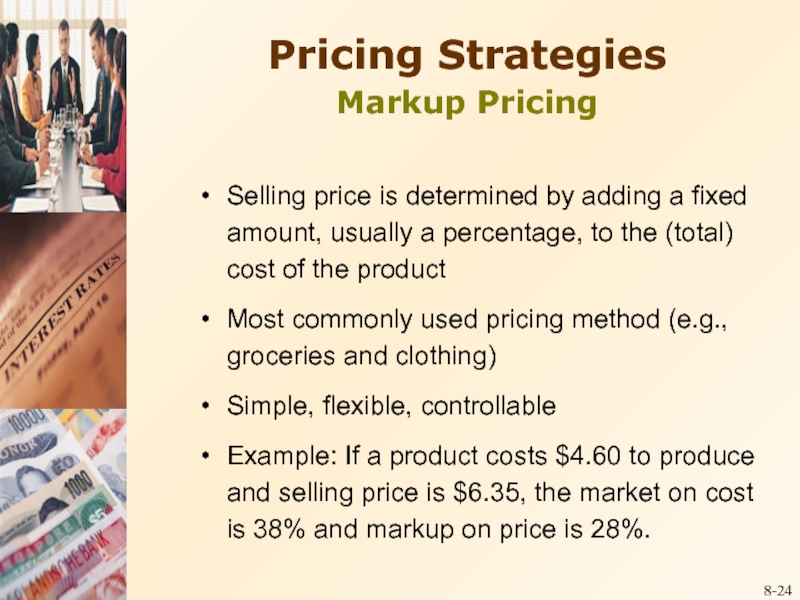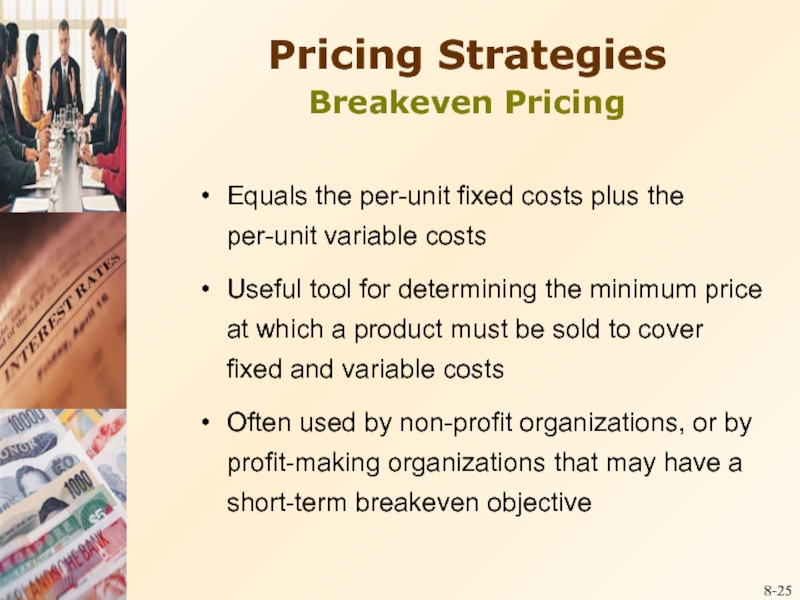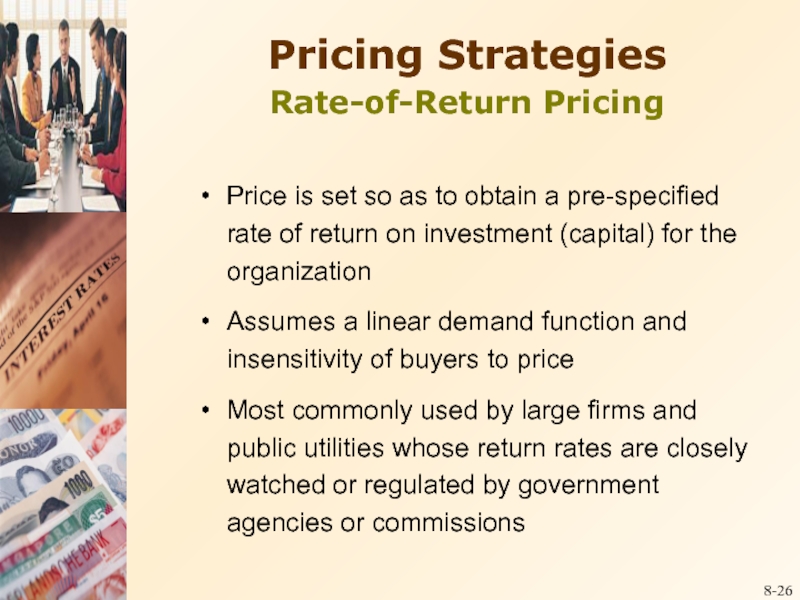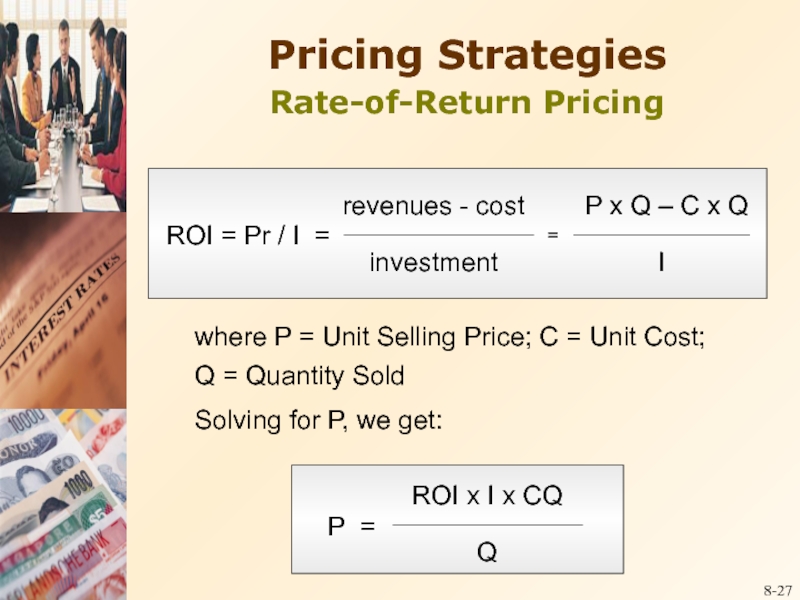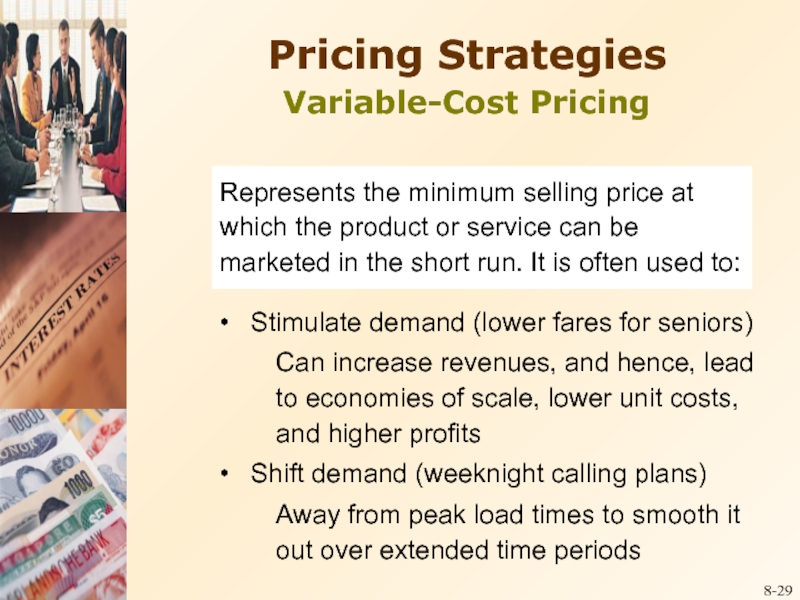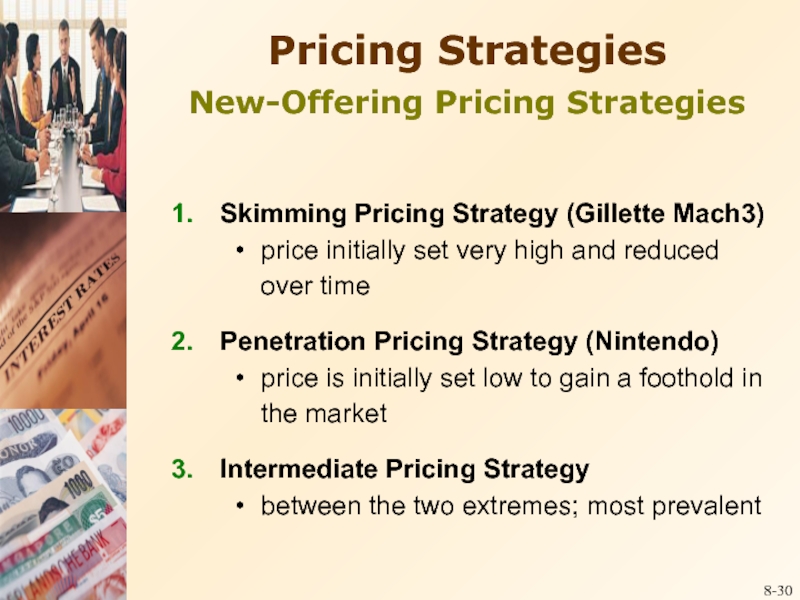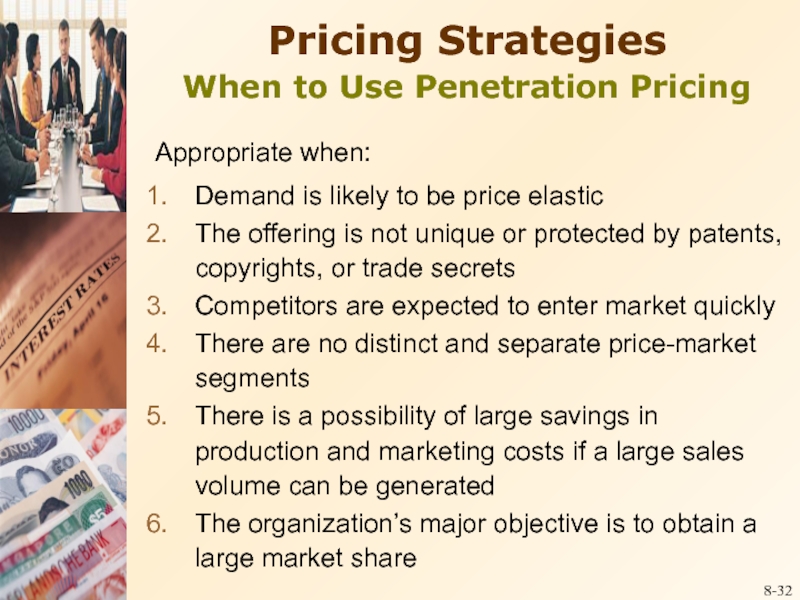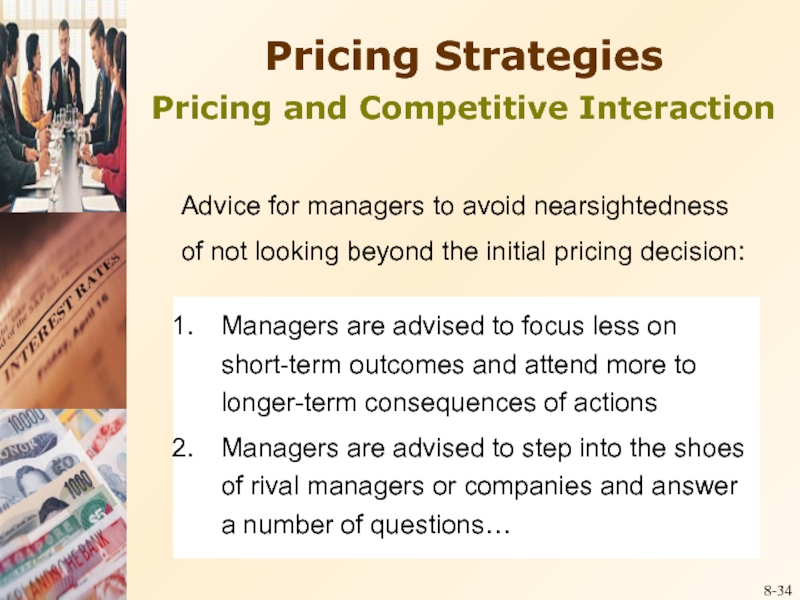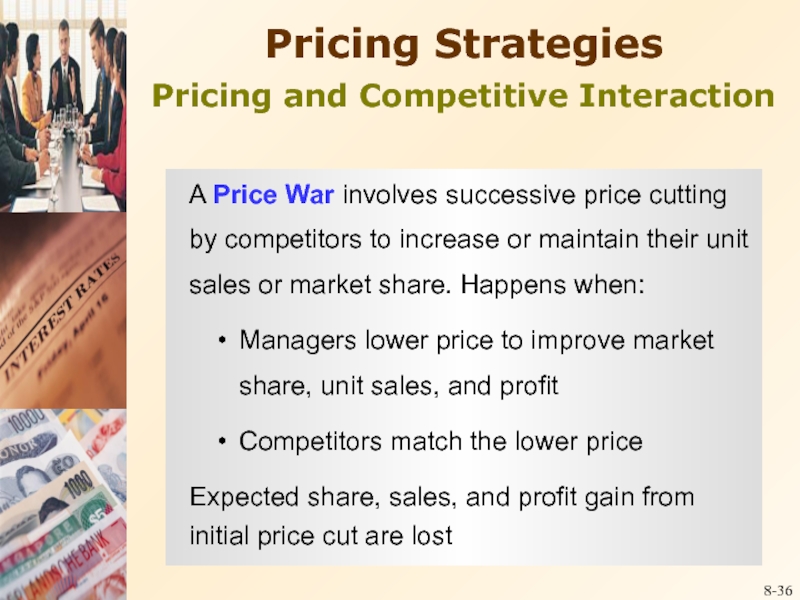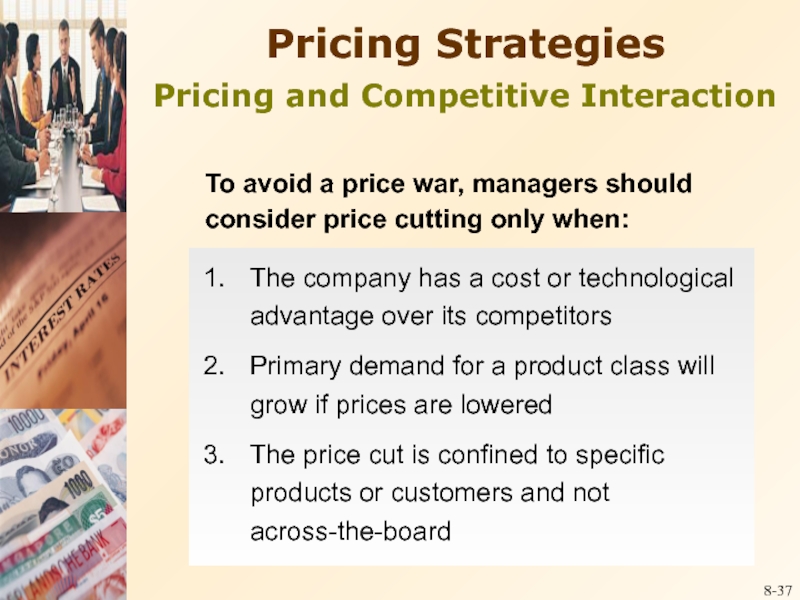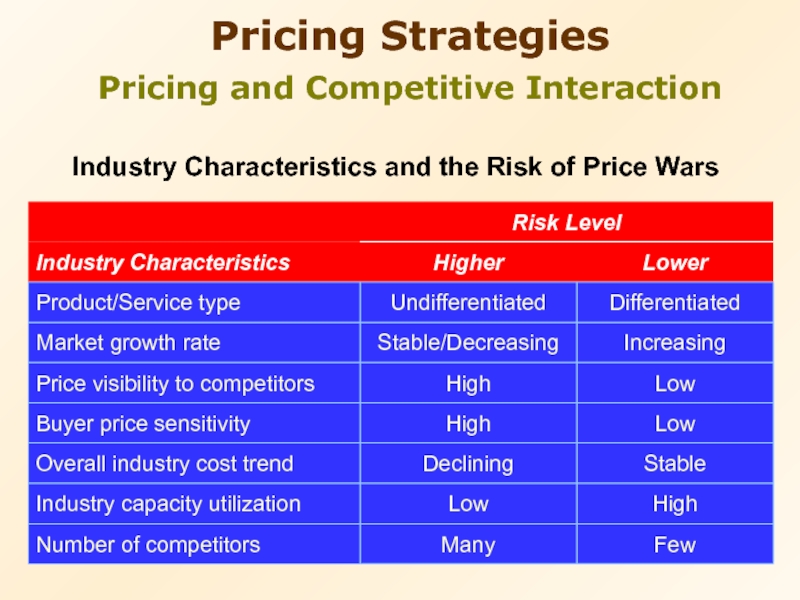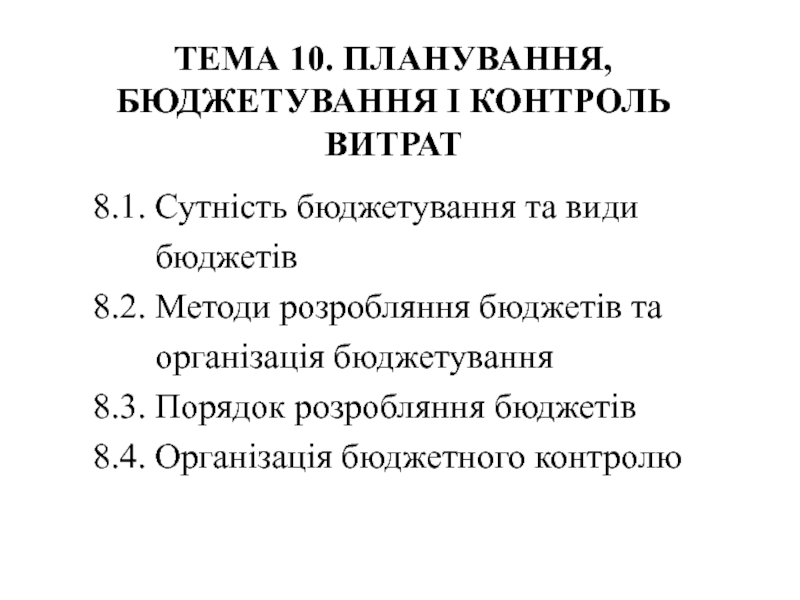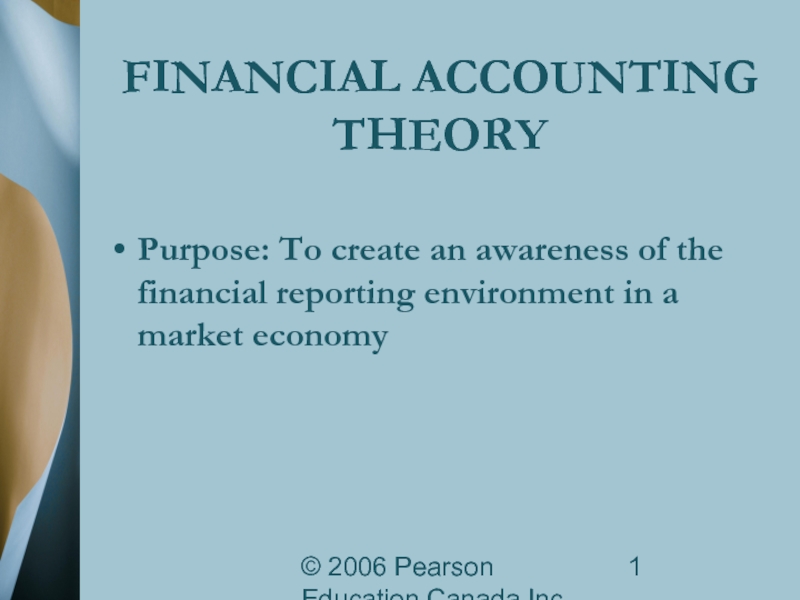- Главная
- Разное
- Дизайн
- Бизнес и предпринимательство
- Аналитика
- Образование
- Развлечения
- Красота и здоровье
- Финансы
- Государство
- Путешествия
- Спорт
- Недвижимость
- Армия
- Графика
- Культурология
- Еда и кулинария
- Лингвистика
- Английский язык
- Астрономия
- Алгебра
- Биология
- География
- Детские презентации
- Информатика
- История
- Литература
- Маркетинг
- Математика
- Медицина
- Менеджмент
- Музыка
- МХК
- Немецкий язык
- ОБЖ
- Обществознание
- Окружающий мир
- Педагогика
- Русский язык
- Технология
- Физика
- Философия
- Химия
- Шаблоны, картинки для презентаций
- Экология
- Экономика
- Юриспруденция
Price. Pricing Considerations презентация
Содержание
- 1. Price. Pricing Considerations
- 2. 8- In this chapter, you will learn
- 3. 8- Price is a direct
- 4. 8- Profit = Total Revenue
- 5. 8- Pricing Considerations Examples of Pricing Objectives:
- 6. 8- Pricing Considerations Demand sets the price
- 7. Pricing Considerations Conceptual Orientation to Pricing Source:
- 8. 8- Pricing Considerations Factors narrowing pricing discretion
- 9. 8- Life-cycle stage of product or service
- 10. 8- Value = perceived benefits price Value
- 11. 8- Price affects perception of quality Price
- 12. 8- Pricing Considerations Price as an Indicator
- 13. 8- E = percentage change in quantity
- 14. 8- If the percentage change in quantity
- 15. 8- The more substitutes the product or
- 16. 8- Pricing Considerations Product-Line Pricing Cross-Elasticity of
- 17. 8- the lowest-priced product and price plays
- 18. 8- Cost data Price data Volume data
- 19. 8- Pricing Considerations Estimating the Profit Impact
- 20. 8- Pricing Considerations Estimating the Profit Impact
- 21. Estimating the Profit Impact from Price Changes
- 22. 8- Pricing Strategies Full-cost Price Strategies Considers
- 23. 8- Pricing Strategies Full-Cost Pricing Full-Cost Pricing Mark-up Pricing Rate-of-Return Pricing Break-even Pricing
- 24. 8- Selling price is determined by adding
- 25. 8- Equals the per-unit fixed costs plus
- 26. 8- Price is set so as to
- 27. 8- Pricing Strategies Rate-of-Return Pricing where P
- 28. 8- Pricing Strategies Rate-of-Return Pricing Example An
- 29. 8- Stimulate demand (lower fares for seniors)
- 30. 8- Pricing Strategies New-Offering Pricing Strategies Skimming
- 31. 8- Demand is likely to be price
- 32. 8- Demand is likely to be price
- 33. 8- Competitive Interaction refers to the sequential
- 34. 8- Managers are advised to focus less
- 35. 8- What are competitors’ goals and objectives?
- 36. 8- Pricing Strategies Pricing and Competitive Interaction
- 37. 8- The company has a cost or
- 38. Pricing Strategies Pricing and Competitive Interaction Number
Слайд 28-
In this chapter, you will learn about…
Pricing Considerations
Price as an Indicator
Price Elasticity of Demand
Product-Line Pricing
Estimating the Profit Impact from Price Changes
Pricing Strategies
Full-Cost Pricing
Variable-Cost Pricing
New-Offering Pricing Strategies
Pricing and Competitive Interaction
Слайд 38-
Price is a direct determinant of profits (or losses)
Price indirectly
Price determines the type of customer and competition the organization will attract
Price affects the image of the brand
A pricing error can nullify all other marketing mix activities
The Importance of Price
Слайд 48-
Profit = Total Revenue – Total Cost
Relationship between Price and
Total Revenue = Price per Unit x Quantity Sold
Total Cost = Fixed Cost + Variable Cost
Слайд 58-
Pricing Considerations
Examples of Pricing Objectives:
Maximization of profits
Enhancing product or brand image
Providing
Obtaining an adequate return on investment or cash flow
Maintaining price stability
Pricing Objectives have to be consistent with an organization’s overall marketing objectives
Слайд 68-
Pricing Considerations
Demand sets the price ceiling
Direct (variable) costs set the price
Campbell Soup’s Intelligent Quisine (IQ) line
Consumers found the products too expensive
Lower price could not cover variable costs
Слайд 7Pricing Considerations
Conceptual Orientation to Pricing
Source: Kent B. Monroe, Pricing: Making Profitable
Слайд 88-
Pricing Considerations
Factors narrowing pricing discretion
Government regulations
Price of competitive offerings
Organizational objectives and
Слайд 98-
Life-cycle stage of product or service
Effect of pricing decisions on profit
Prices of other products and services provided by the organization
Pricing Considerations
Other factors affecting the pricing decision
Слайд 108-
Value = perceived benefits
price
Value can be defined as the ratio of
Pricing Considerations
Price as an Indicator of Value
Слайд 118-
Price affects perception of quality
Price affects consumer perceptions of prestige
Example:
Swiss watchmaker
Raised average price of its watches from $250 to $1000
Sales volume increased sevenfold!
Pricing Considerations
Price as an Indicator of Value
Слайд 128-
Pricing Considerations
Price as an Indicator of Value
Consumer value assessments are often
Consumer’s comparison of costs and benefits of substitute items gives rise to a “reference value”
Слайд 138-
E = percentage change in quantity demanded
percentage change in
Pricing Considerations
Price Elasticity of Demand
Price Elasticity of Demand is a concept used to characterize the nature of the price-quantity relationship
The coefficient of price elasticity, E, is a measure of the relative responsiveness of the quantity of a product demanded to a change in the price of that product
Слайд 148-
If the percentage change in quantity demanded is greater than the
If the percentage change in quantity demanded is less than the percentage change in price, i.e., E<1, then demand is said to be inelastic.
Pricing Considerations
Price Elasticity of Demand
Слайд 158-
The more substitutes the product or service has, the greater the
The more uses a product or service has, the greater the elasticity
The higher the ratio of the price of the product or service to the income of the buyer, the greater the elasticity
Pricing Considerations
Factors affecting Elasticity of Demand
Слайд 168-
Pricing Considerations
Product-Line Pricing
Cross-Elasticity of Demand relates the price elasticity simultaneously to
The Cross-Elasticity Coefficient is the ratio of the change in quantity demanded of product A to a price change in product B
A negative coefficient indicates the products are complementary (camera and film); a positive coefficient indicates they are substitutes (apple and pear)
Слайд 178-
the lowest-priced product and price
plays the role of traffic builder
the highest-priced
positioned as the premium item
price differentials for all other products in the line
reflect differences in their perceived value of the products offered
Product-line pricing involves determining:
Pricing Considerations
Product-Line Pricing
Слайд 188-
Cost data
Price data
Volume data for individual products and services
Impact of price
Pricing Considerations
Estimating the Profit Impact from Price Changes
Слайд 198-
Pricing Considerations
Estimating the Profit Impact from Price Changes
Unit volume necessary to
Слайд 208-
Pricing Considerations
Estimating the Profit Impact from Price Changes
For example, if a
Слайд 228-
Pricing Strategies
Full-cost Price Strategies
Considers both (direct) variable
and (indirect) fixed costs
Variable-cost
Considers only (direct)
variable costs
Слайд 238-
Pricing Strategies
Full-Cost Pricing
Full-Cost Pricing
Mark-up Pricing
Rate-of-Return Pricing
Break-even Pricing
Слайд 248-
Selling price is determined by adding a fixed amount, usually a
Most commonly used pricing method (e.g., groceries and clothing)
Simple, flexible, controllable
Example: If a product costs $4.60 to produce and selling price is $6.35, the market on cost is 38% and markup on price is 28%.
Pricing Strategies
Markup Pricing
Слайд 258-
Equals the per-unit fixed costs plus the per-unit variable costs
Useful tool
Often used by non-profit organizations, or by profit-making organizations that may have a short-term breakeven objective
Pricing Strategies
Breakeven Pricing
Слайд 268-
Price is set so as to obtain a pre-specified rate of
Assumes a linear demand function and insensitivity of buyers to price
Most commonly used by large firms and public utilities whose return rates are closely watched or regulated by government agencies or commissions
Pricing Strategies
Rate-of-Return Pricing
Слайд 278-
Pricing Strategies
Rate-of-Return Pricing
where P = Unit Selling Price; C = Unit
Solving for P, we get:
Слайд 288-
Pricing Strategies
Rate-of-Return Pricing Example
An organization desires an ROI of 15% on
Слайд 298-
Stimulate demand (lower fares for seniors)
Can increase revenues, and hence, lead
Shift demand (weeknight calling plans)
Away from peak load times to smooth it out over extended time periods
Represents the minimum selling price at which the product or service can be marketed in the short run. It is often used to:
Pricing Strategies
Variable-Cost Pricing
Слайд 308-
Pricing Strategies
New-Offering Pricing Strategies
Skimming Pricing Strategy (Gillette Mach3)
price initially set very
Penetration Pricing Strategy (Nintendo)
price is initially set low to gain a foothold in the market
Intermediate Pricing Strategy
between the two extremes; most prevalent
Слайд 318-
Demand is likely to be price inelastic
There are different price-market segments
The
Production or marketing costs are unknown
A capacity constraint in producing the product or providing the service exists
An organization wants to generate funds quickly
There is a realistic perceived value in the product or service
Pricing Strategies
When to Use Skimming Pricing
Appropriate when:
Слайд 328-
Demand is likely to be price elastic
The offering is not unique
Competitors are expected to enter market quickly
There are no distinct and separate price-market segments
There is a possibility of large savings in production and marketing costs if a large sales volume can be generated
The organization’s major objective is to obtain a large market share
Pricing Strategies
When to Use Penetration Pricing
Appropriate when:
Слайд 338-
Competitive Interaction refers to the sequential action and reaction of rival
Pricing Strategies
Pricing and Competitive Interaction
Слайд 348-
Managers are advised to focus less on short-term outcomes and attend
Managers are advised to step into the shoes of rival managers or companies and answer a number of questions…
Pricing Strategies
Pricing and Competitive Interaction
Advice for managers to avoid nearsightedness of not looking beyond the initial pricing decision:
Слайд 358-
What are competitors’ goals and objectives? How are they different from
What assumptions has the competitor made about itself, our company and offerings, and the marketplace? Are these assumptions different from ours?
What strengths does the competitor believe it has and what are its weaknesses? What might the competitor believe our strengths and weaknesses to be?
Pricing Strategies
Pricing and Competitive Interaction
Слайд 368-
Pricing Strategies
Pricing and Competitive Interaction
A Price War involves successive price cutting
Managers lower price to improve market share, unit sales, and profit
Competitors match the lower price
Expected share, sales, and profit gain from initial price cut are lost
Слайд 378-
The company has a cost or technological advantage over its competitors
Primary
The price cut is confined to specific products or customers and not across-the-board
To avoid a price war, managers should consider price cutting only when:
Pricing Strategies
Pricing and Competitive Interaction
Слайд 38Pricing Strategies
Pricing and Competitive Interaction
Number of competitors
Industry capacity utilization
Overall industry cost
Buyer price sensitivity
Price visibility to competitors
Market growth rate
Product/Service type
Lower
Higher
Industry Characteristics
Risk Level
Industry Characteristics and the Risk of Price Wars

